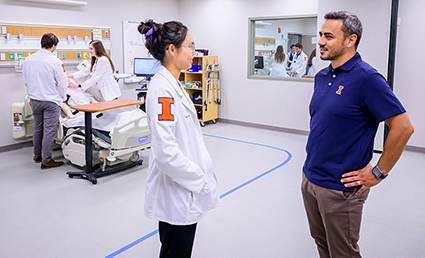Jul 1, 2024
Ahsen wins Young Researcher Award for blending business, tech to improve mammogram screenings
Professor Eren Ahsen’s research fuses the power of business, healthcare, and technology to develop applications that alleviate patient anxiety during mammograms and address disparities in access to these screenings. For his work, Ahsen was recently recognized with the Young Researcher Award at the 14th Conference on Health IT and Analytics (CHITA).

“My goal is to work on applications and products that impact people’s lives,” said Ahsen. “I was drawn to the chance to collaborate with doctors, because in the end I want my research to touch people.”
Ahsen joined Gies Business in 2019 as the College ramped up its business analytics curriculum. In 2022, he added the role of health innovation professor at Carle Illinois College of Medicine. Today, he teaches a business analytics course at Gies where students learn about Python programming and apply basic analytics skills to different industries, such as healthcare, supply chain, and finance. He also mentors PhD and master’s degree students in both colleges.
Eric Hegemann (ACCY ’23), a student who became his teaching assistant for BADM 211: Business Analytics II, said he appreciated how Ahsen gave wide bounds on assignments so that those who wanted to dig deeper had avenues to pursue that.
“One of my great learnings from Professor Ahsen is persistence,” said Hegemann, a data scientist on the people analytics and compensation team at D.E. Shaw & Co., a New York-based hedge fund. “Figure out why something isn’t working and dig into it to make an informed decision about improving a process. I use this approach in every part of my job.”
Ahsen’s own career path is full of persistence and a bit of serendipity. He earned dual bachelor’s degrees in mathematics and electrical and electronics engineering, a master’s degree in control theory in Turkey, and a PhD in biomedical engineering from the University of Texas at Dallas.
At UT Dallas, Ahsen’s research pursuits took a turn when two business faculty members working on a paper asked for help on the mathematical theory in a research project concerning personal risk preferences in breast cancer screening. The collaboration continued, and a subsequent paper on human biases won the best published paper award from Information Systems Research.
“My research continues to involve theory and mathematics, but with a strong focus on practical applications, which is a good balance for me,” said Ahsen, who is also one of a number of Gies faculty contributing to the recently launched Health Care Research Initiative.
In 2015, Ahsen became a postdoctoral researcher at IBM, then transitioned to the Icahn School of Medicine at Mount Sinai as an assistant professor. During this time, he co-organized the Digital Mammography DREAM Challenge born out of the White House’s Cancer Moonshot Initiative. His team objectively analyzed submissions made by participants worldwide, reviewed the effectiveness of machine learning in reading mammograms compared to radiologists, and concluded that even the best algorithm was not as accurate as a human expert.
Today, Ahsen is building on the learnings from that research.
“We’re partnering with a West Coast healthcare system to develop an AI tool that empowers radiologists to deliver faster, more accurate same-day mammogram diagnoses,” said Ahren.
This is welcome news for 40 million women who receive routine exams in the US each year. About 14% get false positives that require additional testing through return visits.
“I cannot imagine the anxiety of getting that call and the time it takes to find the answer,” said Ahsen. “We’re looking for AI to assist in changing the order of mammogram readings from a first-come, first-served basis to one that prioritizes high-risk patients. Our hope is to scale this idea to routine screenings.”
An offshoot of this research is tackling the problem of racial disparity in healthcare decisions.
“The mammographic data shows that some algorithms perform better than others in weeding out bias, and we’re investigating how to reduce those disparities,” said Ahsen. “I look forward to using business analytics to continue to build on what we’re learning so we create effective solutions that work on a broad scale.”


